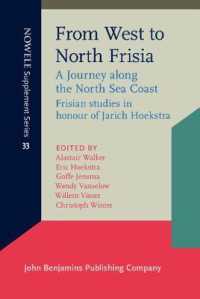- ホーム
- > 洋書
- > 英文書
- > History / World
Full Description
The Archaeology of Political Organization is an examination of settlement in the rich coastal plain of lowland Mesoamerica, a region which was wealthy by Mesoamerican values, with fertile soil and tropical commodities such as jaguars, cacao, avian species with bright plumage, and cotton.
The book provides basic archaeological data about regional settlement from three decades of survey research in south-central Veracruz in the western lower Papaloapan basin, a region with low density urbanism. The data reveals political and social change, with consolidation of wealth by elite families during the Late Classic period.
The political analysis considers archaeological evidence related to several organizational principles: collective versus autocratic, corporate versus exclusionary/network, and segmentary (unspecialized versus specialized). Many variables related to these principles used by other scholars are either suited to historically documented states, not archaeological ones, or ambiguous. Many published studies either focus on a particular city or use documents or other evidence drawn from the top of the settlement hierarchy, characterizing the whole society politically from a biased sample. This political analysis is regional in scope and attentive to variation in the settlement hierarchy, providing a guidepost to analysis of political principles with archaeological data.
Contents
Chapter 1. Setting the Scene
Chapter 2. The Proyecto Arqueologico La Mixtequilla in Context
Chapter 3. Survey Methods and Feature Categories in the Proyecto Arqueologico La Mixtequilla
Chapter 4. Occupational History of the Western Lower Papaloapan Basin
Chapter 5. Concepts and Procedures for Analysis of Monumental Complexes
Chapter 6. Trial Settlement Boundaries, Extents, and a Provisional Settlement Hierarchy
Chapter 7. Monumental Complexes in the Western Central Block of the Blanco Delta
Chapter 8. Monumental Complexes in the Eastern Central Block of the Blanco Delta
Chapter 9. Blanco River Delta Blocks from Speaker's (2001b) Survey
Chapter 10. Monumental Complexes Upriver along the Blanco River, in the Guerengo Drainage, and in the Interfluve
Chapter 11. Monumental Complexes in the Tlalixcoyan Drainage, Paleodunes, and Mangrove Swamp
Chapter 12. Settlement Hierarchy over Time
Chapter 13. Political Interpretation of Settlement Patterns
Appendix 1. Pottery Categories, Chronological Diagnostics, and Monumental Complexes
Appendix 2. Tables of Distances Between Monumental Complexes
Appendix 3. Data and Analysis of Monumental Platforms and Mound-terraces







